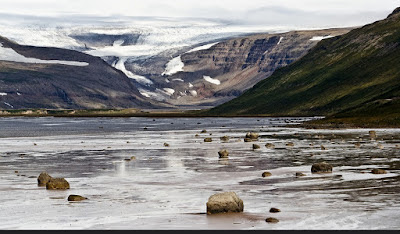======================
An extensive area to the NW of the Kaldalon glacier outlet has now become so thin that bedrock shows through occasionally, and it should be treated as a semi-detaches snowfield. During the surge of 1995 - 2005 Kaldalon Glacier advanced and thickened by about 85m, while in parts of the catchment to the north the ice surface sank by more than 20m.
A 300-year surge history of the Drangajokull ice cap, northwest Iceland, and its maximum during the 'Little Ice Age"
Skafti Brynjólfsson, Anders Schomacker, Esther Ruth Guðmundsdóttir and Ólafur Ingólfsson
The Holocene, Vol. 25(7) 1076–1092
June 2015
Note that the Kaldalon glacier has not just retreated steadily over historic time. It is a periodically surging glacier, as seen on this diagram from Brynjolfsson et al 2015. The seven "surge moraines" seen in the valley (only some of which we noticed in 1960!) represent short-lived glacial advances; these occur irregularly, when conditions are right. The biggest surge since 1740 occurred between 1994 and 1999, when the glacier advanced about 1 km, down the steep trough head slope. These are the periodic interruptions in an overall rather catastrophic retreat. The glacier has thinned by about 250m since 1740. When we were in Kaldalon in 1960, the glacier edge was down on the flatter valley floor. In 1994 the snout was high up on the headwall, but then the last surge brought the snout down to approx the 1960 position again. Since then, retreat has been even more catastrophic, as we can see from the photo at the head of this post.
There is further information in this article:
An extensive area to the NW of the Kaldalon glacier outlet has now become so thin that bedrock shows through occasionally, and it should be treated as a semi-detaches snowfield. During the surge of 1995 - 2005 Kaldalon Glacier advanced and thickened by about 85m, while in parts of the catchment to the north the ice surface sank by more than 20m.





No comments:
Post a Comment